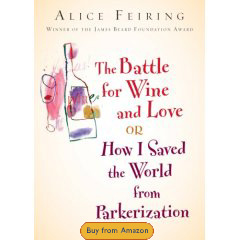Want to know more about wine and why and how it’s ranked? Alice Feiring’s “The Battle for Wine and Love or How I Saved the World from Parkerization” has been named a New York Times Summer Reading Choice. And Alice has a real love for the organics, so she’s written a primer just for Snoety! Read on …
xxx
WHAT IS AN ORGANIC WINE?
If you’ve been avoiding organic wine — thinking it’s silly or malarkey — it’s time to rethink your point of view. Made by wonderful winemakers, they can be great. The only trouble is that the world can’t figure out what organic means.
Wines that are grown organically — no synthetic pesticides, weed killers or vineyard fertilizers — and made naturally are among the purest and most expressive. Take the exalted Domaine Romanée Conti? They’ve been organic, meaning no use of chemical pesticide or weedkillers, since the 1980’s. Domaine Leroy? That domaine makes uber-organic wine according to the principles of biodynamics. And you won’t find any aroma or flavor changing additives in those wines at all. Sure, these particular Burgundies are silly expensive but plenty of others exist at affordable prices. Deciding to love them isn’t a problem. Weeding through the terminology and labeling, in order to decide what is organic enough for you, is.
Sustainable, LIVE or Salmon Safe.
A great idea, but those labels just mean fewer chemicals are used in farming.
Wine made from organic grapes (or biodynamic grapes)
Guess what? Not all the grapes have to be from organic vineyards, in fact up to 25% of the grapes can be chemically farmed. And, what’s more, the wine is most probably made conventionally which means that shape and taste-changing chemicals, additives and process can be used.
Organic Wine
Get the difference? One is about the grapes, and one is about the grapes AND the wine.
Here the percentage of organic grapes in the bottle gets close to 100%. But the main difference is that no sulfites are added. The lack of this preservative is what gave organic wine a bad name, as it is difficult to make stable wine without them.
You see, sulfur as a preservative goes back to Roman times when candles were lit inside amphora* prior to pouring the wine into them. Also, sulfites are a natural byproduct of the wine making process. So, what’s the problem? Today, sulfites are mostly a petrochemical derivative and can spark allergies. For this reason, a few winemakers in Europe seek out elemental sulfur.
Amongst those in the States who take the no sulfur risk are Frey, Coturri and Badger Mountain.
Biodynamic Grapes
Same deal as with organic. The grapes are biodynamic, the wine might not be. This is organic farming to the max with a spiritual edge. Think homeopathy for the vines.
Biodynamic Wine
Demeter is the organization that gives their stamp for European as well as U.S. wines. Biodyvin is another label, certifying in Europe. U.S. rules are stricter, but sulfites are allowed. Mostly you can expect a wine free from flavor, texture and aroma changing additives and process, except for the addition of sulfur.
How And Why To Find Them
Try to determine what matters most to you. If it’s organic farming, that’s the easiest. Just flip over the back of the label to see some declaration of certified organic grapes. Personally, I look for something different. The wine inside has to be as natural as the farming. Sulfur is not an issue for me, because most of the wine I drink is bottled at very low doses.
The wines that most thrill? Grown at least organically and made with no trickery. But, without a sticker that says love me I’m organic and made with no additives. How can they be found?
One tip for foreign wine is to look at the back label for the importer.
Amongst those who import wines that are trustworthy; Louis/Dressner, Jenny & Francois, Neal Rosenthal, Kermit Lynch, Jon David Headrick and Chartrand Imports.
For the domestic wine lover the pickings are much slimmer. More people are growing good grapes but going in another direction in the winery. Those who do walk the walk and talk it as well are Frog’s Leap, Grgich Hills, Frey, Coturri and Ambyth Estate in California, Cayuse in Washington State, Resonance Winery, Brick House and Cameron in Oregon, Silver Thread in the Finger Lakes.
HERE’S ALICE’S BOOK and REVIEWS she’s received. You can just click on the book to purchase from Amazon.
Reviews:
The New York Times (Recommended Summer Reading List on Wine: “Good Wine Reading With Mellow Aftertaste“)
The New York Times (Book Review)
_________________________
*Amphora — a ceramic vase with two handles and a long neck narrower than the body (source: Wikipedia)

